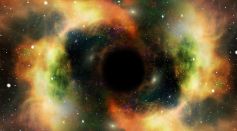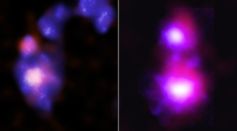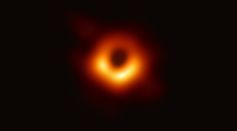Tags: Supermassive black holes
Cosmic Monsters Create Intersections That Lead To Stellar-Mass Black Holes Collisions
Galaxies with Supermassive Black Holes Live Shorter Lives Than Previously Thought

Dusty Supermassive Black Holes Illuminate Radio Emission in Galaxies

How Rare Are Active Supermassive Black Holes? Astronomers Say That SMBHs That Undergo Growth Spurts Are Fewer Than Thought

Two Supermassive Black Holes Circling Each Other in a Distant Galaxy Confirmed in New Observations of Bright Flares

Black Hole Spewing a Fiery Jet at Another Galaxy, Depleting Fuel Needed for Star Formation

NASA's Chandra X-ray Observatory Spotted Two Pairs of Supermassive Black Holes on Collision Course

How Do Supermassive Black Holes Form? Study Reveals Huge Galaxy Mergers During Cosmic Noon Play an Important Role in This Celestial Formation
Supermassive Black Hole Collision Predicted to Happen in 3 Years Using Newly Developed Trajectory Model

Two Supermassive Black Holes Locked Together by Gravity near Galaxy,’ Heading for ‘Titanic Collision’
X-Ray Magnifying Glass of Chandra Gives Enhanced Resolution of Distant Black Holes, Sheds Light on Possible Black Hole System in Early Universe
Research on Supermassive Black Holes Receive the 2020 Nobel Prize in Physics
Supermassive Black Hole Messier 87 Has Been Wobbling for Years
Massive Black Hole Collisions Are Giving Off Detectable Galactic X-ray and Gravitational Waves

Scientists Score Big by Finding Clues to Why Massive Black Holes Form in Spacetime
Supermassive Black Holes Might Unravel The Mystifying Fifth Force Of The Universe
Most Popular

Why Stars Twinkle: Flickering Explained by Atmospheric Turbulence and Light Distortion

The Role of Materials Science in Engineering: How Modern Engineering Materials Drive Innovation

Tornadoes vs. Waterspouts vs. Dust Devils: Key Differences and Vortex Types Explained

Climate Adaptation Strategies Explained: How Societies Respond to Climate Change




